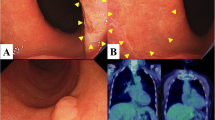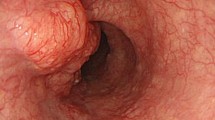Abstract
Pagetoid spread in esophageal squamous epithelium associated with underlying esophageal adenocarcinoma (EAC) has been well studied. Case reports describing pagetoid spread of esophageal squamous cell carcinomas (ESCC) also exist in the literature. The latter, however, has not been systematically studied. In this study, we report seven cases of pagetoid spread associated with ESCC. The clinical, morphologic, and immunophenotypic profiles of pagetoid spread in the context of ESCC and EAC are compared. Cases of pagetoid spread of ESCC were identified through computerized search of pathology archives at five institutions. Additional cases were identified through manual review of surgical resection cases of treatment naive ESCC in Mass General Brigham (MGB) pathology archive. Clinical history was collected via chart review. Immunohistochemistry for CK7, CK20, CDX2, p53, p63, and p40 was performed on selected cases. A computerized search of pathology archives of five institutions revealed only two cases. A manual review of 76 resected untreated ESCC revealed five additional cases with unequivocal pagetoid spread of ESCC, indicating the condition was not uncommon but rarely reported. Patient age ranged from 54 to 78 years (median, 65). There were six women and one man. One case had in situ disease, five had pT1 (1 pT1a and 4 pT1b), and one had pT3 disease. One of the patients with pT1 tumor had a positive lymph node, while the remaining six patients were all N0. Four tumors were in the proximal to mid esophagus, and three in the distal esophagus. Patient survival ranged from 25 months to more than 288 months. The pagetoid tumor cells demonstrated enlarged, hyperchromatic nuclei with variable amounts of eosinophilic cytoplasm. The cytoplasm was often condensed to the perinuclear area, creating peripheral clearing. By immunohistochemistry, the pagetoid cells were positive for p40 (6/6) and p63 (7/7) and negative for CDX2 (7/7). The tumor cells showed mutant-type staining for p53 in five of seven cases. One of the patients had pagetoid tumor cells at the resection margin and subsequently had recurrent disease 2 years later. All other patients had negative resection margins and did not have local recurrence. Four cases of pagetoid spread in the context of EAC were used as a comparison group. Previously published studies were also analyzed. These tumors were all located in the distal esophagus or gastroesophageal junction. All cases were associated with underlying invasive EAC. Pagetoid spread associated with EAC often had cytoplasmic vacuoles or mucin. They were more frequently positive for CK7 than pagetoid ESCC (p = 0.01). Both ESCC and EAC may give rise to pagetoid spread of tumor cells within surface squamous epithelium. Pagetoid spread from ESCC and EAC have overlapping morphologic features. P40 and p63 immunostains can facilitate the distinction between ESCC and EAC. P53 immunostain can aid in confirmation of malignancy. Understanding their overlapping pathologic features will help pathologists avoid pitfalls and diagnose these lesions correctly on biopsy specimens.


Similar content being viewed by others
Data availability
The datasets used and/or analyzed during the current study are available from the corresponding author on reasonable request.
References
Lin DL, Liu J, Yang Z et al (2019) Esophageal invasive acantholytic anaplastic Paget’s disease: report of a unique case. Int J Clin Exp Pathol 12 (6):2293–2297
Mori H, Ayaki M, Kobara H et al (2017) Rare primary esophageal Paget’s disease diagnosed on a large bloc specimen obtained by endoscopic mucosal resection. J Gastrointest Liver Dis 26:417–420. https://doi.org/10.15403/jgld.2014.1121.264.pag
Nonomura A, Kimura A, Mizukami Y et al (1993) Paget’s disease of the esophagus. J Clin Gastroenterol 16:130–135. https://doi.org/10.1097/00004836-199303000-00010
Matsukuma S, Aida S, Shima S, Tamai S (1995) Paget’s disease of the esophagus. A case report with review of the literature. Am J Surg Pathol 19:948–955. https://doi.org/10.1097/00000478-199508000-00011
Abraham SC, Wang H, Wang KK, Wu T-T (2008) Paget cells in the esophagus: assessment of their histopathologic features and near-universal association with underlying esophageal adenocarcinoma. Am J Surg Pathol 32:1068–1074. https://doi.org/10.1097/PAS.0b013e318160c579
Chu P, Stagias J, West AB, Traube M (1997) Diffuse pagetoid squamous cell carcinoma in situ of the esophagus: a case report. Cancer 79:1865–1870
Takubo K, Takai A, Takayama S et al (1987) Intraductal spread of esophageal squamous cell carcinoma. Cancer 59:1751–1757. https://doi.org/10.1002/1097-0142(19870515)59:10%3c1751::AID-CNCR2820591013%3e3.0.CO;2-I
Takubo K (2009) Pathology of the esophagus: an atlas and textbook, 2nd edn. Springer, Tokyo
Chen IY, Bartell N, Ettel MG (2022) Diffuse pagetoid squamous cell carcinoma in situ of the esophagus: a rare case report and review of literature. Int J Surg Pathol 30:326–330. https://doi.org/10.1177/10668969211046814
Simonds RM, Segal RJ, Sharma A (2019) Extramammary Paget’s disease: a review of the literature. Int J Dermatol 58:871–879. https://doi.org/10.1111/ijd.14328
St. Claire K, Hoover A, Ashack K, Khachemoune A (2019) Extramammary Paget disease. Dermatol Online J 25. https://doi.org/10.5070/D3254043591
van der Linden M, Meeuwis KAP, Bulten J et al (2016) Paget disease of the vulva. Crit Rev Oncol Hematol 101:60–74. https://doi.org/10.1016/j.critrevonc.2016.03.008
Matsuoka Y, Iemura Y, Fujimoto M et al (2021) Upper gastrointestinal langerhans cell histiocytosis: a report of 2 adult cases and a literature review. Int J Surg Pathol 29:550–556. https://doi.org/10.1177/1066896920964566
Redleaf MI, Moran WJ, Gruber B (1993) Mycosis fungoides involving the cervical esophagus. Arch Otolaryngol Head Neck Surg 119:690–693. https://doi.org/10.1001/archotol.1993.01880180110022
Liu X, Zhang D, Liao X (2023) Paget cells of the esophagus: a clinicopathologic and immunohistochemical study of 10 cases. Pathology - Research and Practice 242:154345. https://doi.org/10.1016/j.prp.2023.154345
Yada S, Sasaki S, Tokuno K et al (2022) Gastrointestinal: extramammary Paget disease of the esophagus. J Gastroenterol Hepatol 37:419–419. https://doi.org/10.1111/jgh.15665
White H, George S, Gossage J, Chang F (2019) Esophageal Paget’s disease secondary to hypopharyngeal carcinoma: a case report. J Gastrointest Cancer 50:625–628. https://doi.org/10.1007/s12029-018-0087-2
Sano A, Sakurai S, Komine C et al (2018) Paget’s disease derived in situ from reserve cell hyperplasia, squamous metaplasia, and squamous cell carcinoma of the esophagogastric junction: a case report. Surg Case Rep 4:81. https://doi.org/10.1186/s40792-018-0489-1
Haleem A, Kfoury H, Al Juboury M, Al Husseini H (2003) Paget’s disease of the oesophagus associated with mucous gland carcinoma of the lower oesophagus. Histopathology 42:61–65. https://doi.org/10.1046/j.1365-2559.2003.01514.x
Karakök M, Aydın A, Sarı İ et al (2002) Paget’s disease of the esophagus. Dis Esophagus 15:334–335. https://doi.org/10.1046/j.1442-2050.2002.00266.x
Suárez Vilela D, IzquierdoGarcía F, Alonso Orcajo N (1997) Squamous carcinoma of the esophagus with extensive pagetoid dissemination. Gastroenterol Hepatol 20:360–362
Norihisa Y, Kakudo K, Tsutsumi Y et al (1988) Paget’s extension of esophageal carcinoma. Immunohistochemical and mucin histochemical evidence of Paget’s cells in the esophageal mucosa. Acta Pathol Jpn 38:651–658. https://doi.org/10.1111/j.1440-1827.1988.tb02337.x
Author information
Authors and Affiliations
Contributions
TRM and LZ designed the study. TRM, XZ, HMK, SL, NS, LY, MW, VD, JLH, MSR, and LZ collected the data. TRM and LZ analyzed the data. TRM and LZ drafted the manuscript. TRM, XZ, HMK, NS, MW, JLH, and LZ revised the manuscript.
Corresponding author
Ethics declarations
Conflict of interest
TRM, XZ, HMK, SL, NS, LY, MW, MSR, and LZ have no relevant disclosures. VD serves on the Scientific advisory boards of Incyte and Viela and receives research support from Advanced Cell Diagnostic and Agios. JLH is a consultant to Aadi Bioscience, TRACON Pharmaceuticals, Adaptimmune, and Leica Biosystems.
Additional information
Publisher's Note
Springer Nature remains neutral with regard to jurisdictional claims in published maps and institutional affiliations.
Supplementary Information
Below is the link to the electronic supplementary material.
Rights and permissions
Springer Nature or its licensor (e.g. a society or other partner) holds exclusive rights to this article under a publishing agreement with the author(s) or other rightsholder(s); author self-archiving of the accepted manuscript version of this article is solely governed by the terms of such publishing agreement and applicable law.
About this article
Cite this article
Miller, T.R., Zhang, X., Ko, H.M. et al. Esophageal squamous cell carcinoma with pagetoid spread: a clinicopathologic study. Virchows Arch (2024). https://doi.org/10.1007/s00428-024-03788-7
Received:
Revised:
Accepted:
Published:
DOI: https://doi.org/10.1007/s00428-024-03788-7




